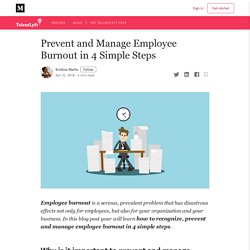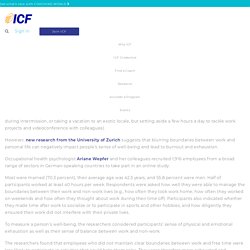

Prevent and Manage Employee Burnout in 4 Simple Steps. Employee burnout is a serious, prevalent problem that has disastrous effects not only for employees, but also for your organization and your business.

In this blog post your will learn how to recognize, prevent and manage employee burnout in 4 simple steps. Employee burnout is a serious, prevalent problem that has disastrous effects not only for employees, but also for your organization and your business. According to the Center for Disease Control (CDC): 40% of employees report their job is very or extremely stressful25% of employees view their jobs as the number one stressor in their lives75% of employees believe the worker has more on-the-job stress than a generation agoProblems at work are more strongly associated with health complaints than are any other life stressor-more so than even financial problems or family problems A survey of 614 HR professionals found that 95 percent of HR leaders said employee burnout was sabotaging workforce retention.
The do’s and don’ts of handling emotions in the workplace. Our Resilience model (incl link to tips on avoiding burnout + fatigue, + managing stress) - Discovery in Action. 30 June or 31 December – which date causes you to have that uncomfortable feeling in the pit of your stomach? Many feel pressured to ‘burn the midnight oil’ to get things finished by these key dates. Many need to work longer hours and / or lead teams who have been working for extended periods towards a key outcome or deadline.
The reality of our busy work lives means there are times in the year when we work with extreme peaks and on the rarer occasions, hit an occasional trough. Sometimes these busy periods can be exciting; when teams really gel and find creative solutions, but finding outlets for stress and finding ways to care for the wellbeing of your team members when there are extended peak periods is critical, both personally and professionally. Previously, we have shared a link to a DiA Tips and hints guide that offered some practical suggestions for how to deal with this leadership challenge – entitled ‘Avoiding and managing fatigue and burnout’.
INFOGRAPHIC: How to Maintain the Well-Being of Your Team - Happify Daily. Growth After Disaster: Going Beyond Resilience. Cant pour from empty cup. To Recover from Burnout, Regain Your Sense of Control. Harvard Research Reveals How Mindful Leaders Develop Better Companies and Happier Employees. Are You Tired of Coaching? - International Coach Federation. At the end of a busy year, coaches look forward to recharging their batteries, restoring depleted energies, and engaging in a little self-care.

In the new year, we feel the benefits of that new energy; we are motivated, excited, ready for action. However, for a few of us, the tiredness may stretch beyond the “normal” fatigue. Compassion fatigue (CF) is defined as a combination of physical, emotional and spiritual depletion associated with caring for people in significant emotional pain and physical distress. While it has long been associated with the medical and therapy professions, there is no doubt that being exposed to other people’s sadness, distress and struggles can have a negative effect on coaches as well.
Coaches who deal with heavy caseloads of struggling clients or who themselves have experienced an inner trauma may be at greater risk for CF. Repeated and chronic exposure to these struggles can affect a coach at a physical, cognitive, emotional and behavioral level. Blurred Work-Life Boundaries Negatively Impact Well-being - International Coach Federation. In the past few years, numerous writers have declared work-life balance unachievable.

Instead, they call for work-life integration, where individuals weave their personal and professional lives together in a way that makes sense for them (e.g., leaving the office early to attend a child’s theater performance and catching up on email during intermission, or taking a vacation to an exotic locale, but setting aside a few hours a day to tackle work projects and videoconference with colleagues). However, new research from the University of Zurich suggests that blurring boundaries between work and personal life can negatively impact people’s sense of well-being and lead to burnout and exhaustion. Occupational health psychologist Ariane Wepfer and her colleagues recruited 1,916 employees from a broad range of sectors in German-speaking countries to take part in an online study.
Most were married (70.3 percent), their average age was 42.3 years, and 55.8 percent were men. The Role Managers Play In Shaping Employee Well-Being.